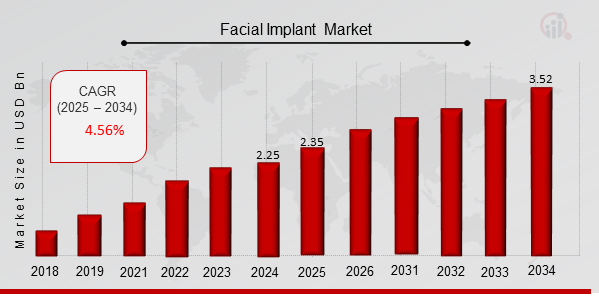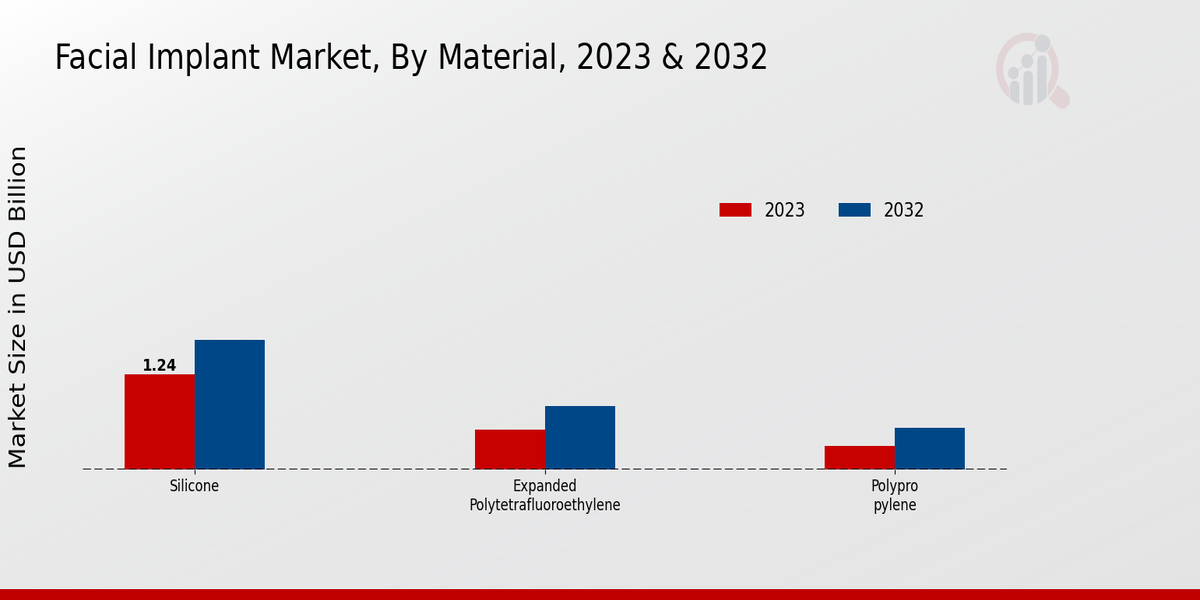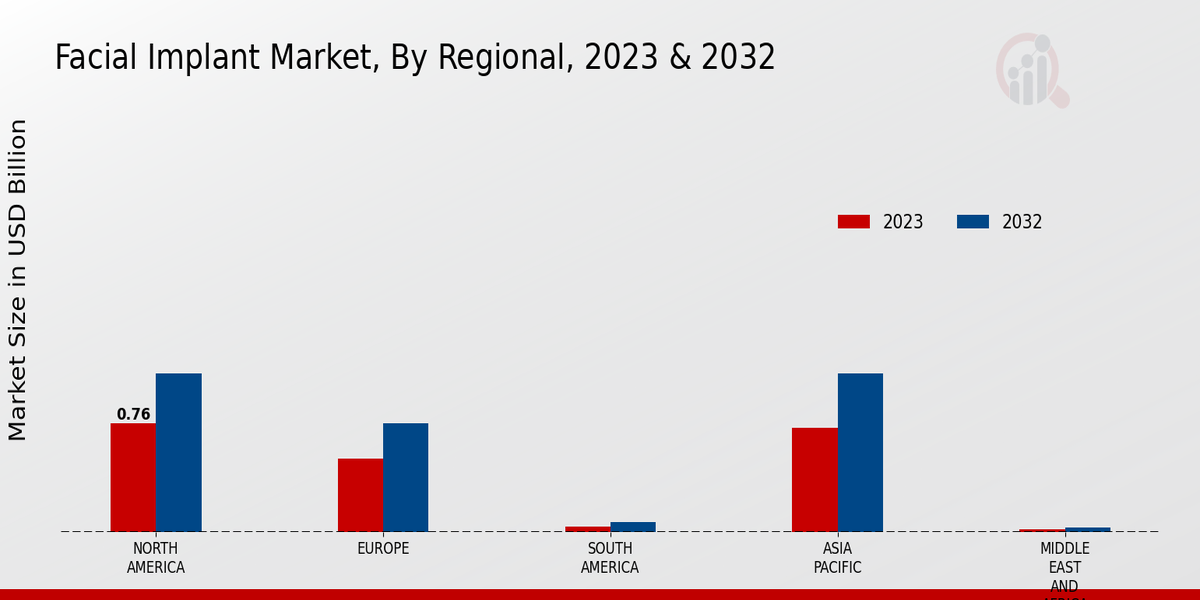Facial Implant Market Overview
As per MRFR analysis, the Facial Implant Market Size was estimated at 2.25 (USD Billion) in 2024. The Facial Implant Market Industry is expected to grow from 2.35 (USD Billion) in 2025 to 3.52 (USD Billion) till 2034, at a CAGR (growth rate) is expected to be around 4.56% during the forecast period (2025 - 2034).
Key Facial Implant Market Trends Highlighted
The Facial Implant Market is experiencing a remarkable expansion, driven by the surging demand for enhanced aesthetics, improvements in implant design, and technological advancements.
Key market drivers include the rising prevalence of facial deformities, increasing awareness of facial aesthetics, and growing acceptance of plastic surgery.
Opportunities for market players lie in developing innovative implant materials, improving implant techniques, and expanding into emerging markets.
Recent trends indicate a surge in demand for minimally invasive facial implants, customized implants based on individual facial anatomy, and the integration of advanced imaging technologies to enhance surgical precision.
Furthermore, the shift towards facial harmonization procedures, where multiple facial implants are used in combination to achieve a balanced and aesthetically pleasing facial appearance, is expected to drive market growth further.
By catering to the evolving needs of patients and leveraging technological innovations, market participants can capture significant opportunities in the facial implant landscape.

Source: Primary Research, Secondary Research, MRFR Database and Analyst Review
Facial Implant Market Drivers
Rising Demand for Cosmetic Procedures
The increasing popularity of cosmetic procedures is a major driver of growth in the Facial Implant Market.
As people become more aware of the potential benefits of facial implants, such as improving facial symmetry, enhancing facial features, and correcting facial deformities, the demand for these procedures is expected to continue to rise.
This is particularly true in emerging markets, where there is a growing middle class with disposable income to spend on cosmetic procedures.
Technological Advancements
The development of new technologies also contributes to the growth of the Facial Implant Market. This will be supported by new, safer, more effective, and affordable materials, and newly developed techniques will also increase the availability of these types of implantations.
Another development that supports this trend is the increasing popularity of 3D printing technology, which makes it possible to create implants precisely based on the needs of a given patient.
Growing Awareness of Facial Deformities
There is a growing awareness of facial deformities, such as cleft lip and palate, and the benefits of facial implants in correcting these deformities.
This is leading to an increase in the number of people seeking facial implant surgery. In addition, government initiatives and programs aimed at providing financial assistance for facial implant surgery are also contributing to the growth of the market.
Facial Implant Market Segment Insights
Facial Implant Market Material Insights
The Facial Implant Market is segmented by material into silicone, expanded polytetrafluoroethylene (ePTFE), and polypropylene. Silicone is the most used material for facial implants due to its biocompatibility, durability, and natural feel.
The Facial Implant Market revenue for silicone implants is expected to reach USD 1.2 billion by 2024, growing at a CAGR of 4.5%. ePTFE is another popular material for facial implants due to its high porosity, which allows for tissue in-growth and reduces the risk of infection.
The Facial Implant Market data for ePTFE implants is expected to reach USD 0.5 billion by 2024, growing at a CAGR of 5.2%.
Polypropylene is a less commonly used material for facial implants due to its stiffness and potential for visibility under the skin. However, it is a relatively inexpensive material, which makes it a good option for patients on a budget.
The Facial Implant Market statistics for polypropylene implants are expected to reach USD 0.3 billion by 2024, growing at a CAGR of 4.0%. The choice of material for a facial implant depends on several factors, including the patient's individual needs, the type of implant being used, and the surgeon's preference.
Silicone implants are generally the most expensive option, but they offer the most natural feel and are less likely to be rejected by the body.
ePTFE implants are a good option for patients who are at risk of infection, and polypropylene implants are a good option for patients on a budget.

Source: Primary Research, Secondary Research, MRFR Database and Analyst Review
Facial Implant Market Implant Type Insights
Facial Implants have gained popularity in the global cosmetic surgery industry, augmenting facial aesthetics and reshaping facial contours. The market segmentation by Implant Type offers valuable insights into the performance of different implant types within the Facial Implant Market.
Chin Implants hold a significant market share, primarily driven by the rising demand for facial contouring procedures. In 2023, the Chin Implants segment was valued at 0.68 (USD Billion) and is projected to reach 1.02 (USD Billion) by 2032, exhibiting a CAGR of 4.9%.
This growth is attributed to the increasing popularity of chin augmentation surgeries to enhance facial balance and definition. Cheek Implants, another prominent segment, witnessed a market value of 0.56 (USD Billion) in 2023.
The segment is expected to expand at a CAGR of 4.7%, reaching 0.87 (USD Billion) by 2032. This growth is driven by the rising demand for cheek augmentation procedures to restore facial volume, improve facial symmetry, and achieve a more youthful appearance. Jaw Implants have also gained traction, with a market value of 0.42 (USD Billion) in 2023.
The segment is projected to reach 0.65 (USD Billion) by 2032, growing at a CAGR of 4.6%. This growth is attributed to the increasing adoption of jaw augmentation procedures to enhance jawline definition, correct facial asymmetry, and improve overall facial aesthetics.
Nasal Implants, although a smaller segment, contribute to the overall Facial Implant Market. With a market value of 0.28 (USD Billion) in 2023, the segment is expected to reach 0.43 (USD Billion) by 2032, exhibiting a CAGR of 4.4%.
This growth is driven by the rising popularity of rhinoplasty procedures to reshape the nose, correct nasal deformities, and improve facial harmony.
Facial Implant Market Procedure Insights
The Facial Implant Market is segmented into Primary Augmentation and Revision Augmentation based on Procedure. Primary augmentation is the most common type of facial implant procedure, accounting for most of the market share.
It involves the insertion of an implant to enhance the size or shape of the face, typically for cosmetic purposes. The most common types of primary augmentation implants are cheek implants, chin implants, and jaw implants.
Revision augmentation is performed to correct or improve the results of a previous facial implant procedure.
This may be necessary due to factors such as implant migration, infection, or dissatisfaction with the initial outcome. The market growth is attributed to increasing demand for cosmetic procedures, rising disposable income, and technological advancements in implant design and materials.
Facial Implant Market Application Insights
The Facial Implant Market segmentation by Application includes Aesthetic and Reconstructive. Reconstructive applications are projected to have a higher market share in 2023, owing to the increasing prevalence of facial deformities, trauma, and accidents.
The growing demand for reconstructive surgeries to improve facial symmetry, restore functionality, and enhance aesthetics is driving the growth of this segment.
On the other hand, the Aesthetic segment is anticipated to witness significant growth over the forecast period due to rising awareness about facial aesthetics and the growing popularity of cosmetic procedures.
The increasing demand for non-invasive and minimally invasive procedures to enhance facial features is contributing to the market growth in this segment.
According to Facial Implant Market data, the Reconstructive segment held a larger market share in 2023, valued at around 1.04 Billion USD. The Aesthetic segment is projected to reach a valuation of approximately 1.27 billion USD by 2032, exhibiting a CAGR of 4.21% during the forecast period.
Facial Implant Market Regional Insights
The regional segmentation of the Facial Implant Market provides insights into the market's geographical distribution and growth potential.
North America is expected to hold the largest market share due to the high prevalence of cosmetic procedures, technological advancements, and strong healthcare infrastructure.
Europe is projected to follow suit, driven by growing demand for facial aesthetics and increasing disposable income.
APAC is poised to witness significant growth, attributed to rising awareness about cosmetic treatments and a growing middle class.
South America and MEA are expected to contribute a smaller share but exhibit steady growth potential.
These regional insights are crucial for businesses operating in the Facial Implant Market as they help identify key target markets, tailor marketing strategies, and optimize resource allocation.

Source: Primary Research, Secondary Research, MRFR Database and Analyst Review
Facial Implant Market Key Players and Competitive Insights
The key companies functioning in the Facial Implant Market are dedicating their efforts to expanding their product portfolio while enhancing their manufacturing capabilities to align with the increasing demand.
Furthermore, the renowned players involved in the Facial Implant Market are focusing on prospective mergers, acquisitions, and strategic partnerships to reinforce their market position while gaining access to new technologies.
As a result, the Facial Implant Market Competitive Landscape is anticipated to be characterized by such developments during the upcoming years. Stryker remains a leading company engaged in the manufacture of facial implants that can be separated into reconstructive or aesthetic categories.
To illustrate, the products offered by Stryker are distinguished by their ability to address facial deformities or defects related to trauma, congenital anomalies, or age-related changes. The status of the company as a global industry player stemmed from the dedication to innovative design and high product quality.
Therefore, the company continues to invest in research and development with the aim of enhancing the product capabilities. Allergan also remains a noteworthy company focused on the manufacture of facial implants.
However, its dominance in the market is underlined by the products designed for aesthetic or reconstructive purposes. The portfolio of the company features an array of silicone-based implants aimed at reshaping or augmenting specific aspects of the face, such as the chin, nose and cheekbones.
The success of Allergan arises from the profound commitment to ensuring patient safety and satisfaction.
Key Companies in the Facial Implant Market Include
- TEOXANENEWPARImplantech
- Hanbi Meditech
- Silimed
- Mentor
- Coapt Systems, LLC
- L. Gore Associates, Inc.
- Allergan
- Establishment Labs Holdings, Inc.
- Polytech
- Zimmer Biomet
- Sientra, Inc.
Facial Implant Market Developments
The increasing demand for facial aesthetic procedures, rising disposable income, and growing awareness about facial implants are driving the market growth.
The market is witnessing the emergence of advanced materials and technologies, such as 3D printing and personalized implants, which are expected to further fuel market expansion.
Key players in the market include Allergan, Stryker, and Mentor Worldwide LLC, among others, who are focusing on product innovation and strategic partnerships to maintain their market position.
Recent developments include the launch of new implant designs and materials, such as porous polyethylene implants and injectable fillers, to meet the diverse needs of patients.
Facial Implant Market Segmentation Insights
Facial Implant Market Material Outlook
- Silicones
- Expanded Polytetrafluoroethylene
- Polypropylene
Facial Implant Market Implant Type Outlook
- Chin Implants
- Cheek Implants
- Jaw Implants
- Nasal Implants
Facial Implant Market Procedure Outlook
- Primary Augmentation
- Revision Augmentation
Facial Implant Market Application Outlook
Facial Implant Market Regional Outlook
- North America
- Europe
- South America
- Asia-Pacific
- Middle East and Africa
| Report Attribute/Metric |
Details |
|
Market Size 2024
|
2.25 (USD Billion)
|
|
Market Size 2025
|
2.35 (USD Billion)
|
|
Market Size 2034
|
3.52 (USD Billion)
|
|
Compound Annual Growth Rate (CAGR)
|
4.56 % (2025 - 2034)
|
|
Report Coverage
|
Revenue Forecast, Competitive Landscape, Growth Factors, and Trends
|
|
Base Year
|
2024
|
|
Market Forecast Period
|
2025 - 2034
|
|
Historical Data
|
2020 - 2024
|
| Market Forecast Units |
USD Billion |
| Key Companies Profiled |
TEOXANENEWPARImplantech, Hanbi Meditech, Silimed, Mentor, Coapt Systems, LLC, W. L. Gore Associates, Inc., Allergan, Establishment Labs Holdings, Inc., Polytech, Zimmer Biomet, Sientra, Inc. |
| Segments Covered |
Material, Implant Type, Procedure, Application, Regional |
| Key Market Opportunities |
Advancement in 3D Printing Growing Demand for Non-invasive Procedures Technological Advancements in Facial Implants Increased Global Demand for Aesthetic Procedures Expansion into Emerging Economies |
| Key Market Dynamics |
Increasing demand for cosmetic procedures Growing popularity of minimally invasive procedures Rising disposable income in emerging markets Technological advancements in implant materials Expansion of application areas in reconstructive surgery |
| Countries Covered |
North America, Europe, APAC, South America, MEA |
Frequently Asked Questions (FAQ) :
The Facial Implant Market size was valued at 2.25 billion USD in 2024 and is projected to reach 3.52 billion USD by 2034, exhibiting a CAGR of 4.56% during the forecast period.
North America is expected to dominate the Facial Implant Market throughout the forecast period due to factors such as the rising prevalence of facial deformities and increasing demand for cosmetic surgeries.
Facial implants are primarily used for cosmetic and reconstructive purposes. Cosmetic applications include chin augmentation, cheek augmentation, and jawline contouring. Reconstructive applications include facial reconstruction after trauma or surgery and correction of facial deformities.
Key competitors in the Facial Implant Market include Allergan, Stryker, Mentor, and Implantech. These companies offer a range of facial implants made from materials such as silicone and expanded polytetrafluoroethylene (e-PTFE).
The growth of the Facial Implant Market is attributed to factors such as the rising demand for cosmetic surgeries, increasing awareness about facial implants, and technological advancements in implant design and materials.
Challenges faced by the Facial Implant Market include stringent regulatory frameworks, concerns regarding implant safety and efficacy, and the availability of non-surgical alternatives.
Emerging trends in the Facial Implant Market include the development of customized implants, the use of 3D printing technology for implant design and manufacturing, and the growing adoption of minimally invasive surgical techniques.
The COVID-19 pandemic had a negative impact on the Facial Implant Market due to the postponement of elective surgeries and disruptions in the supply chain. However, the market is expected to recover in the post-pandemic period as demand for cosmetic procedures increases.
Key opportunities for growth in the Facial Implant Market include the development of innovative implant materials, expansion into emerging markets, and the growing popularity of non-invasive facial rejuvenation procedures.
Key challenges for growth in the Facial Implant Market include regulatory hurdles, concerns about implant safety, and the availability of non-surgical alternatives.

















